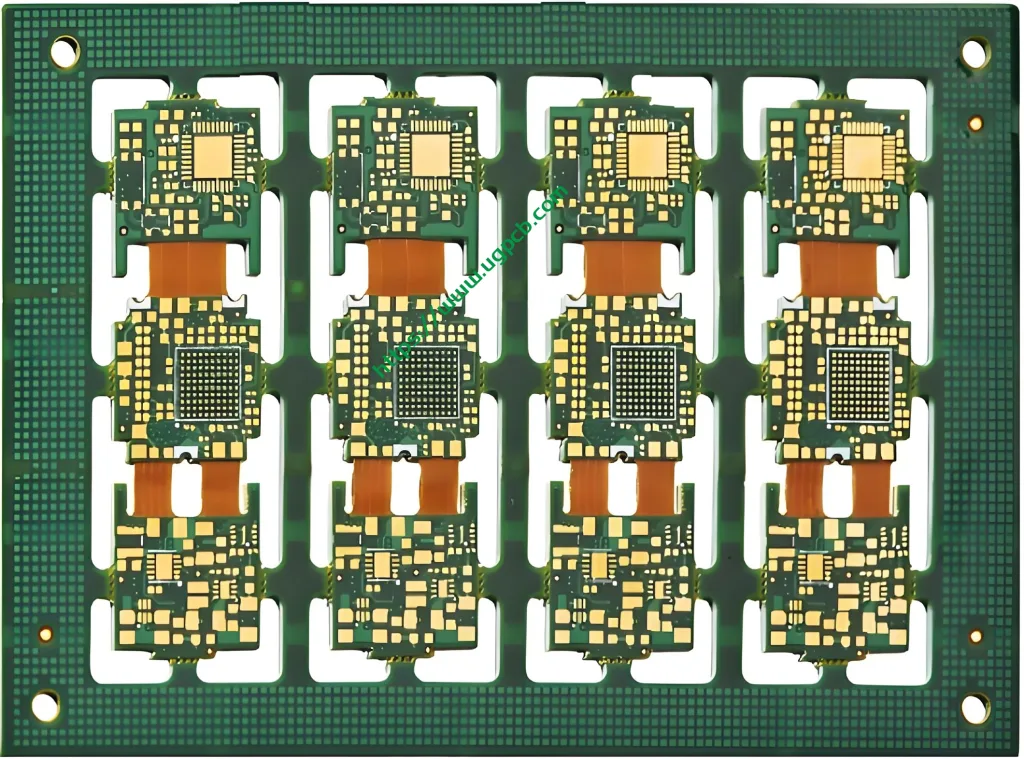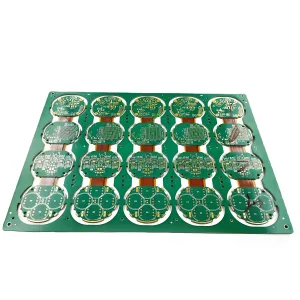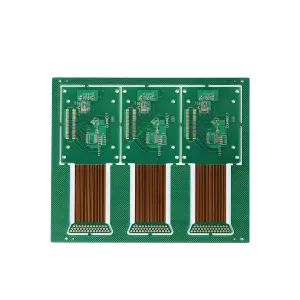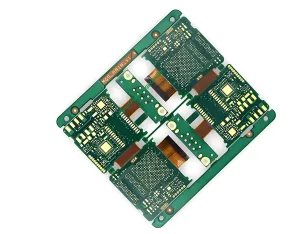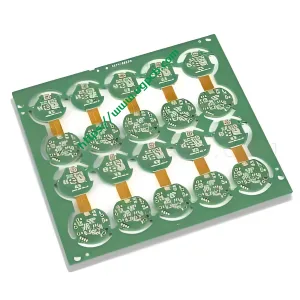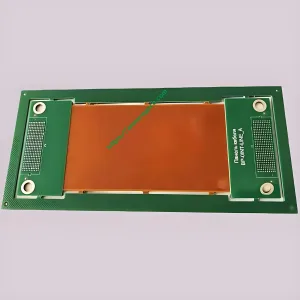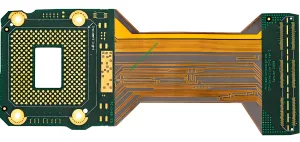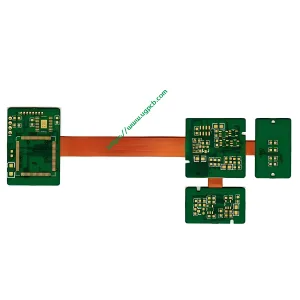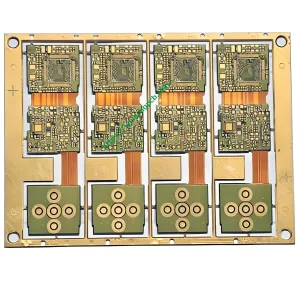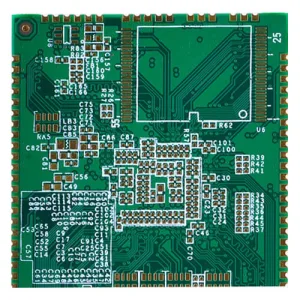Rigid-Flex PCB 외부 층 패턴의 보호 재료, 즉, 솔더 마스크, 일반적으로 선택할 수있는 세 가지 유형이 있습니다. 첫 번째 유형은 전통적인 커버 필름입니다 (표지), 폴리이 미드 물질의 직접 층이며 접착제. 에칭 후 보호 해야하는 회로 보드로 적층됩니다.. 이러한 종류의 커버 필름은 누르기 전에 사전 형식이 필요합니다, 용접 할 부분을 노출시킵니다, 따라서 더 미세한 조립의 요구 사항을 충족시킬 수 없습니다. 두 번째 유형은 감광성 개발 유형 커버 드라이 필름입니다., 라미네이터로 누른 후, 용접 부분은 감광성 개발 방법을 통해 유출됩니다., 어셈블리 섬광 문제를 해결합니다. 세 번째 유형은 액체 스크린 인쇄 유형 커버링 재료입니다., 폴리이 미드 물질이 일반적으로 사용됩니다, 태양 광, 이 재료는 파인 피치의 요구 사항을 더 잘 충족시킬 수 있습니다, 유연한 보드의 고밀도 어셈블리.
RID-FLEX PCB 생산 공정 및 주요 부품 제어
Ridid-Flex PCB. 프로세스 제조 측면에서 강성 PCB 보드와 많은 유사점이 있습니다.. 하지만, RID-FLEX PCB 재료와 구조 및 응용의 특수성으로 인해 일반적인 강성 PCB 보드 및 유연한 PCB 보드와는 다르다고 결정합니다.. 전체 프로세스를 최적화하기 위해 거의 모든 생산 링크를 테스트하고 조정해야합니다.. 프로세스 및 매개 변수.
Ridid-Flex PCB 내부 층 모 놀리 식의 패턴 전달
그래픽 전송은 고밀도에서 매우 중요한 위치를 차지합니다, 박막 PCB, 특히 유연한 회로의 경우. 유연한 모 놀리식이 얇고 부드럽기 때문입니다, 표면 처리와 같은 작업에 큰 어려움을 가져옵니다., 그리고 구리 포일 표면의 깨끗한 상태와 거칠기는 저항 드라이 필름의 접착력과 미세한 선 생산에 직접적인 영향을 미칩니다.. 기계식 닦기에는 높은 장비가 필요하기 때문입니다, 부적합한 압력은 기질 변형을 유발할 수 있습니다, 컬링, 크기 확장, 등., 작업은 제어하기 쉽지 않습니다, 그래서 우리는 전해 세정 방법을 사용하도록 선택할 수 있습니다.. 이 방법은 표면 청결을 보장 할 수 없습니다, 또한 마이크로 에칭 방법을 사용하여 구리 표면의 거칠기를 보장합니다., 라인 너비/간격이 0.1mm ~ 0.15mm 인 라인 패턴의 생성에 도움이됩니다.. 산 에칭에서, 에칭 속도를 제어하여 디자인에 필요한 선 너비 및 간격을 보장합니다., 또한 단일 칩이 컬링 및 주름을 막는 것을 방지해야합니다.. 보조 가이드 플레이트를 추가하고 장비의 환기 시스템을 닫는 것이 가장 좋습니다..
유연한 재료의 다층 포지셔닝
유연한 기판의 치수 안정성은 열악합니다. 폴리이 미드 물질은 강한 수분 흡수를 가지고 있기 때문입니다. 습식 처리 후 또는 온도 및 습도 환경에서, 그들은 심각하게 축소되고 변형됩니다, 다층 PCB 층이 생성됩니다. 반대의 어려움. 이 어려움을 극복하기 위해, 다음 조치를 채택 할 수 있습니다: 디자인에서, 정렬 모티프 및 대상 펀칭 지점의 설계를 고려해야합니다., 정렬 구멍이나 리벳 구멍을 펀칭 할 때 정확성을 보장하기 위해, 플레이트를 쌓을 때 유용하지 않습니다. 레이어 간 그래픽의 오정렬은 스크래핑으로 이어집니다..
OPE 펀칭 후 구멍 위치는 습식 처리 중 재료 확장 및 수축으로 인한 오류를 제거 할 수 있습니다..
PCB 라미네이션 후, X-ray를 사용하여 구멍을 드릴 구멍을 사용하여 오프셋을 결정하여 드릴링을보다 정확하게 만듭니다.. 폴리이 미드의 물질적 특성과 환경 적 특성에 따라, 외부 필름은 드릴링 오프셋을 참조하여 그려져 외부 필름과 드릴링 보드 사이의 중첩을 개선합니다.. 이런 식으로, 인터레이어 등록을 위해 0.1mm ~ 0.15mm 링 너비의 요구 사항을 충족 할 수 있습니다., 외부 레이어 그래픽 전송의 정확도를 확인하십시오.
RIDID-FLEX PCB 라미네이션
OPE로 위치결정 구멍을 뚫어도, 적층 전 단일 칩 처리는 레이어 간 정렬에 큰 영향을 미칩니다.. 가장 먼저, 폴리이 미드 물질은 강한 알칼리에 내성이 없기 때문에, 강력한 알칼리 솔루션에서 팽창 할 것입니다. 그러므로, 검은 색과 갈색의 과정에서, 탈지와 같은 강력한 알칼리성 공정, 검은 색과 갈색은 적절하게 줄여야합니다. 온도, 시간을 줄입니다. 접착제 층이없는 기본 재료가 사용되기 때문입니다, Lye에서 접착제 층의 변화를 고려할 필요가 없습니다., 이 방법은 여전히 가능합니다. 둘째로, 산화 처리 후 단일 칩 베이킹은 수직으로 배치해야합니다., 굽힘 변형을 줄이고 가능한 한 평평하게 유지하기 위해 수평 베이킹을 채택해야합니다.. 베이킹 후, 단일 조각이 수분을 다시 흡수하지 못하도록 성형 시간을 최대한 줄입니다..
유연한 단일 시트는 변형하기 쉽기 때문입니다, 라미네이션 전 평탄도는 열악합니다, 그리고 사용 된 접착제 시트의 수지 유동성은 강성 PCB 보드 라미네이션에 사용되는 Prepreg의 유동성보다 훨씬 낮습니다.. 그러므로, 접착제 시트와 단일 시트 좋은 조합을 미세한 선 간격에 포함시키기 위해, 우리는 라미네이트 개스킷 재료로 더 나은 덮개 모양을 가진 재료를 사용하도록 선택합니다., 폴리 프로필렌 필름과 같은, 폴리테트라플루오로에틸렌 (PTFE), 실리콘 고무 시트, 등., 유연한 보드의 라미네이션을 향상시킬 수 있습니다. 품질. 시험 후, 이상적인 개스킷 재료는 실리콘 고무 재료라고 생각됩니다., 그 형태 성을 보장하고 프레스 부분의 수축과 변형을 상대적으로 줄일 수 있습니다..
PCB 하드 보드 부품의 경우, 다음 세 가지 측면은 프레스 과정에서주의를 기울여야합니다.
- PCB 기판 라미네이션 또는 순수한 Prepreg Lamination인지 여부, 유리 천의 워프와 씨름 방향은 일관성이 있어야합니다., 라미네이션 공정 중에 열 응력을 제거하여 휘세를 줄여야합니다..
- PCB 리지드 보드는 일정한 두께를 가져야 합니다., 유연한 부분은 매우 얇고 유리 천이 없기 때문에. 환경과 열충격에 영향을 받은 후, 변화는 엄격한 부분과 다릅니다. 단단한 부분에 특정 두께 또는 경도가없는 경우, 이 차이는 매우 분명 할 것입니다, 사용 중에 심각한 변형이 발생합니다., 용접 및 사용에 영향을 미칠 것입니다. 단단한 부분이 일정한 두께나 경도를 가지고 있는 경우, 이 차이는 중요하지 않은 것처럼 보일 수 있습니다. 유연한 부분의 변화에 따라 평탄도는 변하지 않습니다., 용접 및 사용을 보장할 수 있는. 단단한 부분이 너무 두꺼운 경우, 무겁고 비경제적으로 보일 것입니다. 실험 결과 0.8~1.0mm의 두께가 더 적합하다는 것이 입증되었습니다..
- 유연한 창의 처리, 일반적으로 첫 번째 밀링 및 중식 후 방법이 있습니다., 하지만 Rigid-Flex PCB 자체의 구조와 두께에 따라 유연하게 가공해야 합니다.. 밀링의 정확성을 보장하기 위해 유연한 창이 먼저 밀링 된 경우, 용접이나 처짐은 너무 많이 영향을받지 않아야합니다.. 밀링 데이터는 엔지니어링에 의해 생성 될 수 있습니다, 유연한 창을 미리 밀링할 수 있습니다.. 유연한 창을 먼저 밀지 않으면, 그런 다음 레이저 절단을 사용하여 이전 프로세스를 모두 완료 한 후 유연한 창의 폐기물을 제거하고 마지막으로 형성합니다., 레이저가자를 수있는 FR4의 깊이에주의를 기울여야합니다..
프레스 매개 변수는 유연한 기판 및 강성 PCB 보드의 프레스 매개 변수를 참조하여 포괄적으로 최적화 할 수 있습니다..
RID-FLEX PCB 드릴링
Rigid-Flex PCB의 구조는 복잡합니다, 따라서 구멍 벽을 얻기 위해 드릴링 구멍에 가장 적합한 프로세스 매개 변수를 결정하는 것이 매우 중요합니다.. 내부 구리 링의 네일 헤드 현상과 유연한 기본 재료를 방지하기 위해, 날카로운 드릴 비트를 먼저 선택해야합니다. 처리 할 인쇄판의 수가 크거나 처리 된 보드의 구멍 수가 큰 경우, 특정 수의 구멍이 뚫린 후 드릴 비트를 제 시간에 교체해야합니다.. 드릴의 속도와 피드는 가장 중요한 프로세스 매개 변수입니다.. 피드가 너무 느리면, 온도가 급격히 상승하고 많은 드릴링 먼지가 생성됩니다.. 피드가 너무 빠른 경우, 드릴 비트를 깨는 것은 쉽습니다, 접착제 시트와 미디어 층의 찢어짐 및 네일 헤드 현상.
둘째로, 드릴링 머신을 선택하고 드릴링 매개 변수는 플레이트 두께와 최소 드릴링 직경에 따라 최적화해야합니다.. 현재, 도달 할 수있는 드릴링 머신이 있습니다 200,000 업계의 분당 혁명. 작은 구멍의 경우, 속도가 높을수록, 드릴링의 품질이 높아집니다. 동시에, 커버 및 후원 보드의 선택도 매우 중요합니다.. 좋은 덮개 및 후원 보드 보드 표면을 보호 할뿐만 아니라, 그러나 열 소산에도 좋은 역할을합니다. 후원 보드는 알루미늄 포일 보드 또는 에폭시 접착제 보드를 사용하는 것이 가장 좋습니다., 종이 후원 판을 사용하지 마십시오, 종이 뒷면 판이 부드럽고 심각한 시추 버기가 발생하기 때문에. 지루하기 전에 디버링 할 때, 구멍을 찢거나 긁는 것은 쉽습니다, 후속 프로세스에 문제를 일으키고 Ridid-Flex PCB에 영향을 미칩니다..
 UGPCB 로고
UGPCB 로고

